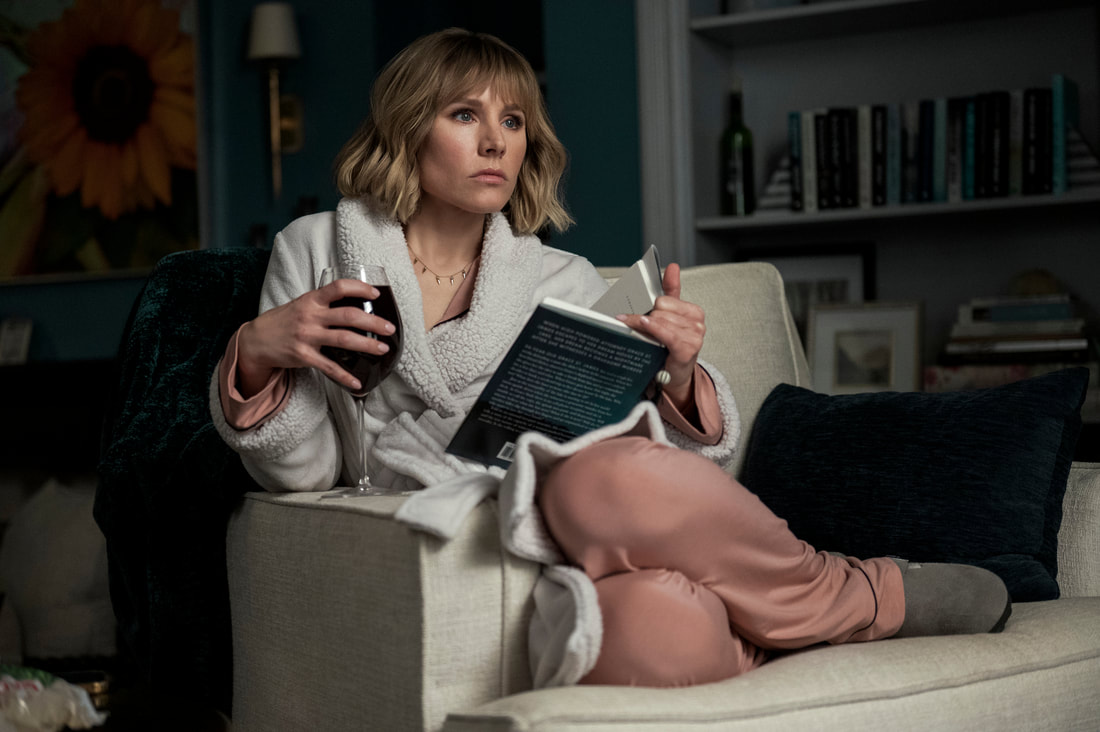|
Kristen Bell in The Woman in the House Across the Street from the Girl in the Window (2022) The line between sincerity and satire is very thin in the adeptly titled Netflix limited series, The Woman in the House Across the Street from the Girl in the Window. Starring and executive-produced by Kristen Bell, The Woman in the House (for short) is a smattering of psychological thrillers that center on “the hysterical woman,” one whose eye witness accounts of crimes are chalked up to “just imagining things”. Series creators Rachel Ramras, Hugh Davidson and Larry Dorf stretch this plot device to eight thirty-minute episodes, each throwing a wrench in expectations. So much is at play in the story, filled with subplots as extra as the series title. In a pile of twists and turns thrown at the viewer, The Woman in the House finds what works and delivers it on a tightrope. At first, it’s a mystery whether the story will fully lean into its satirical slant, if it will surrender to absurdity or carve something more ingenuous from the chaos. The series pokes fun at all the tropes and cliches to be found in its derivative material. The creators also find interesting points to chew on that speak to the addictive quality of psychological murder-mystery stories, and what keeps the viewer hungry in anticipation for a new reveal. The earlier episodes stumble most from standing out amongst the very stories they satirical aim at. Once the screenplay finds its groove, though not particularly memorable in afterthought, it’s easy to fall down the binge-worthy rabbit hole of The Woman in the House. Every night, Anna (Kristen Bell) fills up her glass with wine and cozies up on her sofa by the window, watching the lives of others while hers stays the same. Anna suffers from Ombrophobia, a fear of rain originating from a personal tragedy involving rain. The extreme anxiety attacks keep her inside most nights as a precaution in case skies turn grey. But when neighbor Neil (Tom Riley) and his daughter Emma (Samsara Leela Yett) move in across the street, possibilities light up for Anna. Perhaps a fresh start, a new relationship…a picturesque family to fill the void following a traumatic experience. Stepping outside becomes a little easier. A future seems within reach, until one night she witnesses a murder. Or did she? The age-old question in countless psychological thrillers, ones that portray women’s experiences as hallucinations, that everything they see is actually all in their head and not a serious threat in real life. Most recently, Joe Wright’s adaptation of The Woman in the Window epitomizes the “hysterical woman” not to be trusted, using its protagonist’s mental illness as a means of discrediting her experiences. This is just one of many familiar threads The Woman in the House touches upon, in a way that combines satire with straightforwardness. There’s a wink and a nudge to cliche, and beneath that, a trusting quality towards the protagonist. After Anna witnesses a murder and tells people what she saw, the responses are excessively and expectedly skeptical. Anna’s point of view is deliberately shrouded in hallucination and making the viewer question what is real. But with each episode, the series further stresses there’s a nugget of truth to her perspective. At first it’s not clear which direction the creators want to take. Will the creators fully lean into the satirical slant? Are they trying to find something fresh from a mishmash of repetitive psychological mystery plot devices? The Woman in the House is a bit of both, and while it takes some time to find a happy medium, the absurdity of it all along with an ensemble of game actors make the experience entertaining. Kristen Bell is an actress whose work is mostly unfamiliar to me, hit television shows Veronica Mars and The Good Place being the biggest blind spots. Bell finds plenty to have fun with as Anna, walking that tightrope of playing satire with utmost sincerity. Once a thriving painter, now finds herself drowning in wine and watching life pass her by, reading books like ‘The Woman on the Cruise’. The character lives vicariously through others, with a yearning underneath to somehow return to what her life once was. Bell perfects that duality and gives a performance well suited to the repetitive material. The dialogue moves amusingly in circles, with some vague inspirational quotes thrown in, saying a lot of words without actually saying anything. Bell and a strong supporting cast know exactly what they’re in and deliver fun performances, flipping multiple sides to their characters and adding intrigue to the story. Each episode uses subplots as building blocks, finding so many variations of similar material as the title clearly references. Yet there is still something about this psychological mystery storytelling that makes it easy for the viewer to feel invested and stay for the reveals, of which the series has plenty. Being glued to the screen, for answers to a story soaked in silliness, speaks to its binge-power. Is there much to ponder and chew on when it’s all over? Not quite, but the creators earn their chuckles along the way, indulging in the twists and concluding with their juiciest reveal. The creators have the last laugh with The Woman in the House Across the Street from the Girl in the Window. Keeping the viewer guessing and present in the moment, it’s a series best to binge and enjoy the ride, with a glass of wine or two. All episodes of The Woman in the House Across the Street from the Girl in the Window arrive January 28 on Netflix.
0 Comments
Leave a Reply. |
Archives
June 2024
Categories |


 RSS Feed
RSS Feed